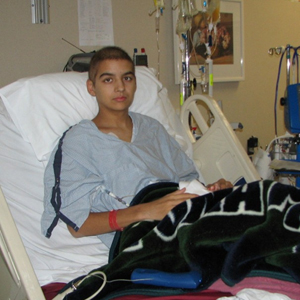Diagnosing Non-Hodgkin Lymphoma
A number of tests are performed to evaluate a child with the suspected diagnosis of cancer. The initial test is a physical exam and identification of abnormal findings. Other tests are performed based upon the findings and symptoms and may include some of the following:
If cancer cells are found during the surgical removal of a tumor, biopsy, or examination of abnormal fluids in the chest or abdomen, more tests will need to be performed. The additional tests will determine whether cancer cells have spread to other parts of the body.
Expand all sections Close all sections
Determining the Extent of Disease
Non-Hodgkin lymphoma has a standardized staging system. Staging identifies the extent of the cancer and is an important factor in determining appropriate treatment.
Stage I
The cancer is found only in one lymph node or in one area of the body (except the chest or abdominal area).
Stage II
The cancer is found in:
- One area and the lymph node near it on the same side of the diaphragm (a thin muscle separating the chest cavity from the abdominal cavity)
- In two areas or two lymph nodes on the same side of the diaphragm
- One lymph node or area in the abdomen
Stage III
The cancer is found:
- On both sides of the diaphragm (in lymph nodes or areas)
- In the chest cavity
- Tumor in the abdomen
- Near the spine
Stage IV
The cancer may be found in any of the places listed in Stages I-III but has definitely spread to the brain, spinal cord and/or bone marrow.
Sometimes B-cell non-Hodgkin lymphoma is grouped according to the French-American-British (FAB) risk classification and treatment is determined based on that classification.
- Group A: Tumors that can be completely removed together with any accompanying lymph nodes.
- Group B: Any tumor(s) that cannot be surgically removed, do not occur in the brain, and tumor cells make up less than 25% of cells in the bone marrow
- Group C: Tumor cells are in the brain, spine or spinal fluid, and/or greater than 25% of cells in the bone marrow are tumor cells
Several other factors affect the treatment type and cure rate, including:
- Tumor stage: Earlier stage tumors (I or II) usually have a better outcome than higher stage tumors (III or IV).
- Extent or volume of the cancer: Size of the primary tumor, whether or not lymph nodes are involved and to what parts of the body the tumor has spread will determine the treatment needed and the response to therapy.
- Lymphocyte biology: There are a number of different types of non-Hodgkin lymphoma. The lymphocytes of patients with different types of non-Hodgkin lymphoma have a different appearance under the microscope. Each of the specific types of non-Hodgkin lymphoma requires a specific treatment approach.
Causes of Non-Hodgkin Lymphoma
Researchers don’t know the cause of most cases of non-hodgkin lymphoma, but do know that B and T lymphocytes are prone to making mistakes or developing variations. These mistakes are known as mutations. Sometimes mutations can lead to new cells multiplying without older cells dying off, as is the normal process. These lymphocytes can grow locally (in lymph nodes or tonsils), or spread to distant sites in the body through the bloodstream or lymph vessels.
Researchers are aware of a few risk factors for non-Hodgkin lymphoma. Boys are two to three times more likely to develop non-Hodgkin lymphoma before age 20 compared to girls. For every two girls diagnosed, about five boys are diagnosed. Caucasian children are about 40% more likely to develop non-Hodgkin lymphoma compared to African American children. In addition, children with impaired immune system are more likely to develop non-Hodgkin lymphoma than other children. Children with these conditions are more at risk for non-Hodgkin lymphoma, but they account for only a small fraction of cases.

